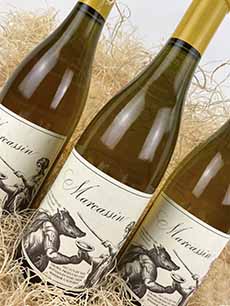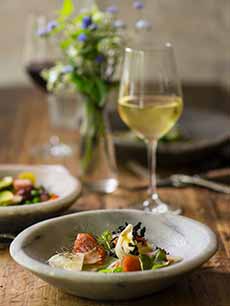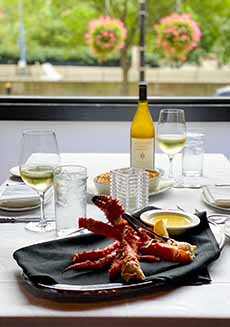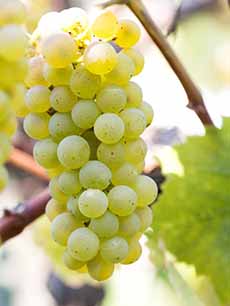|
May 27th is National Chardonnay Day, and International Chardonnay Day is celebrated on the Thursday before the last Monday in May. That may sound complex, but it’s the Thursday before Memorial Day. So…time to open a bottle!
Chardonnay is the world’s most popular white wine: a dry, medium- to full-bodied wine with moderate acidity and alcohol levels. It can be grown in a variety of climates.
THE STYLES OF CHARDONNAY
Between the terroir and the winemaker, Chardonnay can have different personalities.
Chardonnay can be crisp, clean, and minerally like Chablis, or rich and oaky like Mersault.
It can be light and elegant, or full-bodied and buttery.
It can have notes of apple and lemon or “tropical fruits” like papaya and pineapple.
In cool climates such as Chablis and the Carneros AVA of California, Chardonnay has more noticeable acidity and the flavors of green plum, apple, and pear.
In warmer areas of the New World, including Australia and the Marlborough region of New Zealand), the flavors become more citrus, peach, and melon.
In very warm locations, such as the Central Coast AVA of California, more fig and tropical fruit notes such as banana and mango appear.
If it’s aged in oak, it can have hints of vanilla or butterscotch.
Fat, rich, oaky styles with higher alcohol can handle heavier cream sauces and grilled meats with higher fat content. The key is to match the wine’s weight with the weight of the food.
Wines that the winemaker has put through malolactic fermentation tend to have softer acidity and fruit flavors, with a buttery mouthfeel and hazelnut notes. The malolactic is a secondary fermentation that transforms tart malic acid into softer lactic acid. Or, as one of our wine experts notes, “Think green apples to cream.”
So there’s a perfect Chardonnay for every palate and every food pairing.
> The history of Chardonnay is below.
CHARDONNAY & FOOD PAIRING
Due to the wide range of styles, Chardonnay can be paired with a diverse spectrum of food types.
Thanks to La Crema, maker of great California Chardonnay, for these tips:
DO Pair Chardonnay With:
Buttery, creamy, or mild dishes.
Meaty fish (halibut, cod) and shellfish (lobster, shrimp, crab, scallops).
Subtly flavored, simply seasoned poultry, pork, and veal dishes.
Dishes that have a silky texture, such as risottos and cream-enhanced soups, sauces and pastas.
Pairings By Style
Oaky Chardonnay with foods that have toasty flavors, toasted nuts, savory pastry crusts, grilling or smoking.
Crisp, delicate Chardonnay with simply flavored, simply prepared foods, such as raw bar shellfish, baked fish, or poultry with butter and herbs.
Crisp, higher-acid Chardonnay with tomato-based dishes and items featuring sweet onions.
Crisp, delicate Chardonnay with mild, semi-soft cheeses, including goat cheese.
Moderately oaked Chardonnay with buttery and creamy cheeses, Gouda, Gruyère, and Alpine-style varieties.
Heavily oaked Chardonnay with smoked fish, spicy southeast Asian cuisine, and garlic.
Heavily oaked Chardonnay with the big flavors of Asiago, Cheddar, Fontina, Havarti, Parmesan, and washed-rind cheeses.
Ripe Chardonnay—with sweetness from warmer clients—with ingredients such as corn, butternut squash, sweet potatoes, and foods that are caramelized from roasting or grilling, like crisp-skinned roast chicken.
Older, more mellow Chardonnay with more earthy dishes, like mushroom soup and aged cheese.
DON’T Pair Chardonnay With:
Aggressively seasoned food. Avoid fresh or dried chilies and super spicy dishes, including much of Chinese, Indian, and Southeast Asian fare.
Bitter foods: bitter greens and vegetables, and spices like turmeric—they’ll make the wine taste sour.
Acidic foods, such as raw tomatoes, olives, capers, ceviche, and tangy vinaigrettes and sauces.
Pungent or high-acid cheeses. Avoid funky, washed-rind cheeses (taleggio, Époisse) and aged goat and sheep’s cheese.
DO & DON’T Temperatures
Don’t serve Chardonnay too cold; the cold dulls its pairing powers.
The best temperature range is 50°–55°F, which can be achieved by two hours in the fridge or 30–40 minutes in an ice-water bath in an ice bucket.
Remove the bottle from the ice bucket or refrigerator 15 to 20 minutes before pouring.
There’s enough to know about Chardonnay to fill several books—and quite a few have been written about it.
CHARDONNAY HISTORY
The Chardonnay grape, a green-skinned white wine grape, originated in the Burgundy region of France, and Chardonnay from Burgundy is the world’s most expensive. It is the grape that makes the great Burgundies Chablis, Meursault, Montrachet, and Pouilly-Fuissé.
Chardonnay is also one of two primary base grapes for the sparkling wines of Champagne, along with Pinot Noir and the blending grape, Pinot Meunier.
The grape takes its name from a commune (small town or village) in the Mâconnais region of southern Burgundy, which today makes relatively simple, inexpensive Chardonnays.
The name of the town derives from cardonnacum, the “place full of thistles.” The commune recently celebrated its thousandth anniversary
From there, Chardonnay most likely was then spread throughout France by Cistercian monks.
The grape reached its apex when it moved north to Burgundy, where the cooler climate and the overall terroir were perfect to elevate the complexity of the grape.
The earliest recorded reference to Chardonnay occurs in 1330. Cistercian monks built stonewalls around their Clos de Vougeot vineyard in Burgundy, exclusively planted with Chardonnay grapes [source].
A Great Cross-Breeding
Chardonnay is a crossbreed. Many centuries ago, growers in the Chardonnay area created the Chardonnay grape by crossing their local Pinot Noir grape with Gouais Blanc (Heunisch), a white grape thought to have brought by the Romans from Croatia.
It was widely cultivated by peasants in eastern France [source], and the wine immediately became a local favorite.
But it wasn’t until the 14th century when the Cistercian monks popularized it to make their wine in Burgundy [source].
It has long been the second-most-planted white wine grape in France.*
|
|

[1] Puligny Montrachet, one of the great white Burgundies, is made from 100% Chardonnay grapes (photos © Christies).

[2] Chardonnay is the most-planted white wine grape in California (photo © La Crema Chardonnay).

[3] Marcassin is the most expensive California Chardonnay, made by a great winemaker, Helen Turley, in very small amounts, in the Burgundy style. It costs hundreds of dollars per bottle (photo © Cult Wine).

[4] California Chardonnay with a cheese plate (photo © California Wine Institute).

[5] Chardonnay pairs well with sushi and sashimi (photo © Pampano | NYC).

[6] In fact, Chardonnay is a popular choice with all fish and shellfish—here with King Crab legs (photo © The Palm | NYC).

[7] Chardonnay grapes (photo © Erin Malone | California Wine Institute).
|
Chardonnay Today
While there were several claims to Chardonnay’s “true” origins, modern DNA fingerprinting by Dr. Carole Meredith at the University of California, Davis, has finally identified Chardonnay as the cross between the Pinot Noir and Gouais Blanc grape varieties.
If you’ve never heard of Gouais Blanc, it’s because it’s nearly extinct grape.
Wine made from Gouais Blanc was not well liked even back in the day. It has been actively dug up over the centuries, its vineyards replanted with other varieties, leading to its now “nearly extinct” situation [source].
But we are grateful that it was around when needed to create one of the great wine grapes of the world.
Chardonnay, Gamay Noir, and many other classic varieties† can be traced back to this cross of Pinot and Gouais Blanc.
Today Chardonnay is planted the world over. In the U.S., the grape is grown in Northern California, Washington State, and Oregon—the three largest plantings in the U.S.—New York State, Texas, and Virginia.
Chardonnay is the most widely planted white variety in California, on a par with the plantings of Cabernet Sauvignon.
Wine trivia: Ampelography is the field of botany concerned with the identification and classification of grapevines. Traditionally this was done by comparing the shape and color of the vine leaves and grapes; however, the field has been revolutionized by DNA fingerprinting.
________________
*The most planted white wine grape in France is Ugni Blanc, an Italian grape from Tuscany, where it is known as Trebbiano. It largely used to make brandy in the Cognac and Armagnac regions of France.
†Grape varieties that trace back to Gouais Blanc and Pinot include Aligoté, Aubin vert, Auxerrois, Bachet noir, Beaunoir, Dameron, Franc noir de la Haute, Saône, Gamay blanc Gloriod, Gamay noir, Knipperlé, Melon, Peurion, Romorantin, Roublot and Sacy. That’s a lot of relatives! [source]
CHECK OUT WHAT’S HAPPENING ON OUR HOME PAGE, THENIBBLE.COM.
|






